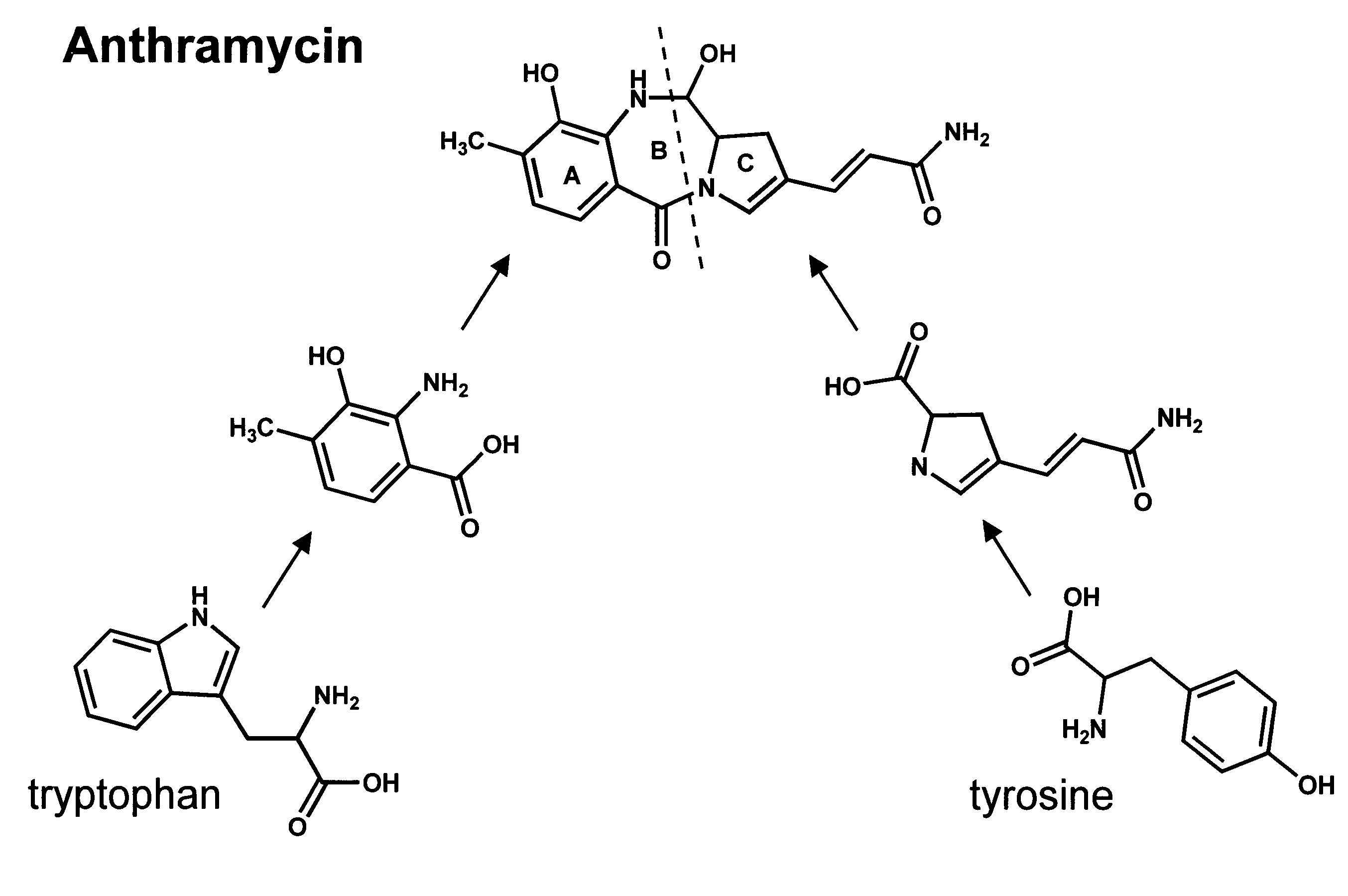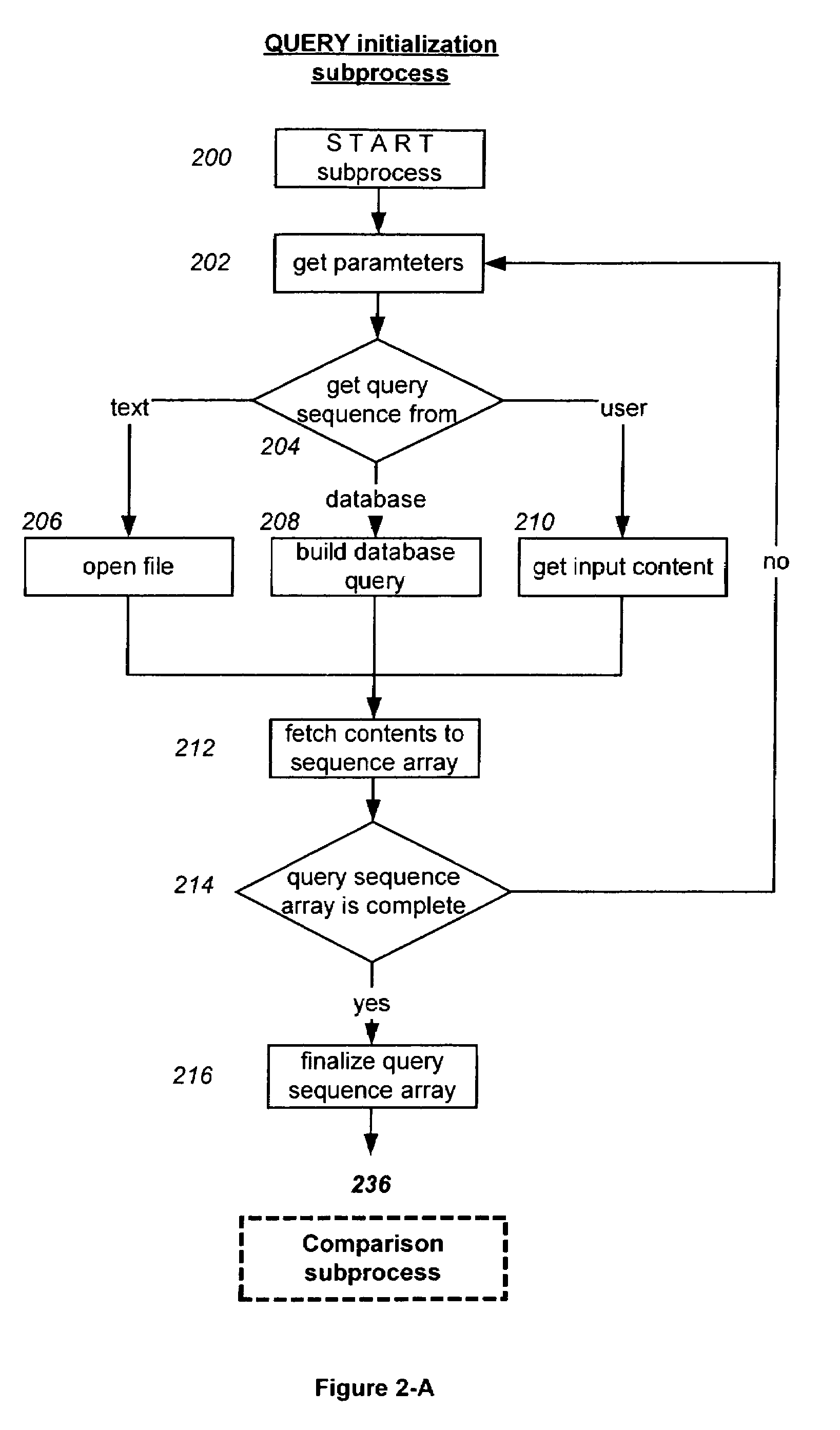Nucleic acid fragment encoding an NRPS for the biosynthesis of anthramycin
a technology of anthramycin and nucleic acid, applied in the field of nucleic acid molecules, can solve the problems of insufficient discrimination, laborious screening methods, and inability to identify benzodiazepine-producing microorganisms, and achieve the effect of reducing the number of benzodiazepine-producing bacteria
- Summary
- Abstract
- Description
- Claims
- Application Information
AI Technical Summary
Benefits of technology
Problems solved by technology
Method used
Image
Examples
example 1
Identification and Sequencing of the Anthramycin Biosynthetic Gene Cluster
[0141]Streptomyces refuineus subsp. thermotolerans NRRL 3143 was obtained from the Agricultural Research Service collection (National Center for Agricultural Utilization Research, 1815 N. University Street, Peoria, Ill. 61604) and cultured using standard microbiological techniques (Kieser et al., (1982) Mol. Gen. Genet 185(2), 223-228). This organism was propagated on oatmeal agar medium at 28 degrees Celsius for several days. For isolation of high molecular weight genomic DNA, cell mass from three freshly grown, near confluent 100 mm petri dishes was used. The cell mass was collected by gentle scraping with a plastic spatula. Residual agar medium was removed by repeated washes with STE buffer (75 mM NaCl; 20 mM Tris-HCl, pH 8.0; 25 mM EDTA). High molecular weight DNA was isolated by established protocols (Kieser et al. (1982), Mol. Gen. Genet. 185(2), 223-228) and its integrity was verified by field inversion...
example 2
Genes and Proteins Involved in Biosynthesis of Anthramycin
[0149]The anthramycin locus includes the 32,539 base pairs provided in SEQ ID NO: 1 and contains the 25 ORFs provided SEQ ID NOS: 3, 5, 7, 9, 11, 13, 15, 17, 19, 21, 23, 25, 27, 29, 31, 33, 35, 37, 39, 41, 43, 45, 47, 49, 51. More than 15 kilobases of DNA sequence were analyzed on each side of the anthramycin locus and these regions contain primary metabolic genes. The accompanying sequence listing provides the nucleotide sequence of the 25 ORFs regulating the biosynthesis of anthramycin and the corresponding deduced polypeptides, wherein ORF 1 (SEQ ID NO: 3) represents the polynucleotide drawn from residues 1863 to 1 (antisense strand) of SEQ ID NO: 1, and SEQ ID NO: 2 represents the polypeptide deduced from SEQ ID NO: 3; ORF 2 (SEQ ID NOS: 5) represents the polynucleotide drawn from residues 3388 to 1886 (antisense strand) of SEQ ID NO: 1 and SEQ ID NO: 4 represents the polypeptide deduced from SEQ ID NO: 5; ORF 3 (SEQ ID N...
example 3
Formation of Anthramycin
[0158]The chemical structure of anthramycin contains an aromatic ring (ring A in FIG. 5), a 7-member diazepine ring (ring B in FIG. 5) and a proline-like ring (ring C in FIG. 5). The genes and proteins of the invention explain formation of anthramycin. The aromatic ring of anthramycin is derived from the amino acid L-tryptophan and the proline-like ring of anthramycin is derived from the amino acid L-tyrosine via the intermediates shown in FIG. 5. Twelve genes, ORFs 1 to 7, 9 and 12 to 15 (SEQ ID NOS: 3, 5, 7, 9, 11, 13, 15, 19, 25, 27, 29 and 31 respectively), encode enzymes involved in transformation of L-tyrosine into the proline-like precursor that forms the C-ring of anthramycin. Six genes, ORFs 16 to 19, 23 and 24 (SEQ ID NOS: 33, 35, 37, 39, 47 and 49) encode enzymes involved in the conversion of L-tryptophan into the substituted anthanilate precursor that becomes the aromatic-ring of the compound. Two genes, ORFs 21 and 22 (SEQ ID NOS: 43 and 45) enco...
PUM
| Property | Measurement | Unit |
|---|---|---|
| pH | aaaaa | aaaaa |
| pH | aaaaa | aaaaa |
| Tm | aaaaa | aaaaa |
Abstract
Description
Claims
Application Information
 Login to View More
Login to View More - Generate Ideas
- Intellectual Property
- Life Sciences
- Materials
- Tech Scout
- Unparalleled Data Quality
- Higher Quality Content
- 60% Fewer Hallucinations
Browse by: Latest US Patents, China's latest patents, Technical Efficacy Thesaurus, Application Domain, Technology Topic, Popular Technical Reports.
© 2025 PatSnap. All rights reserved.Legal|Privacy policy|Modern Slavery Act Transparency Statement|Sitemap|About US| Contact US: help@patsnap.com



